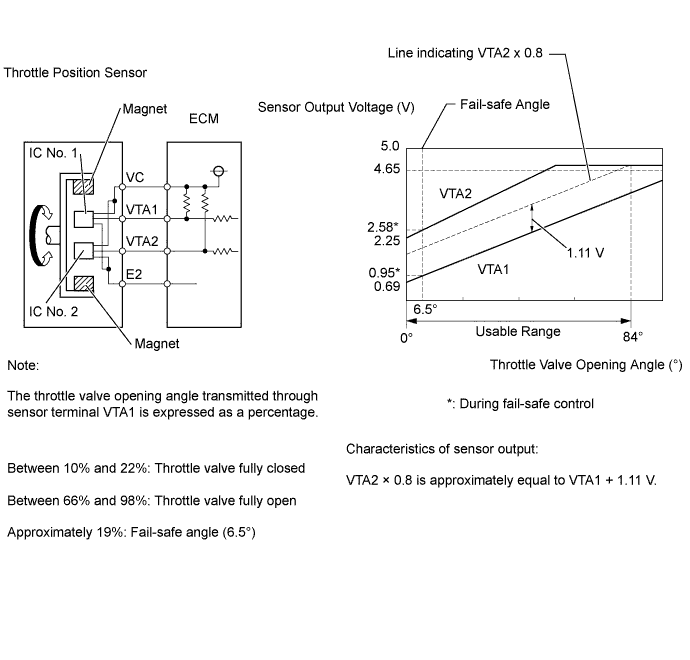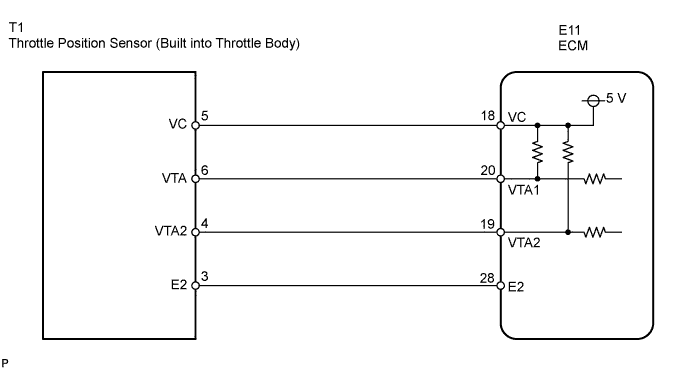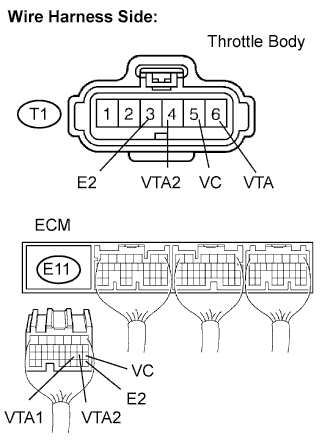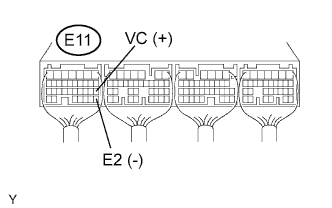Dtc P0120/41 Throttle / Pedal Position Sensor / Switch A Circuit
DESCRIPTION
MONITOR DESCRIPTION
FAIL-SAFE
WIRING DIAGRAM
INSPECTION PROCEDURE
When using intelligent tester:
READ DATA LIST (THROTTLE POSITION NO. 1, THROTTLE POSITION NO. 2)
CHECK HARNESS AND CONNECTOR (THROTTLE POSITION SENSOR - ECM)
CHECK ECM (VC VOLTAGE)
REPLACE THROTTLE BODY ASSEMBLY
CHECK IF DTC OUTPUT RECURS (THROTTLE POSITION SENSOR DTCS)
When not using intelligent tester:
CHECK HARNESS AND CONNECTOR (THROTTLE POSITION SENSOR - ECM)
CHECK ECM (VC VOLTAGE)
REPLACE THROTTLE BODY ASSEMBLY
CHECK IF DTC OUTPUT RECURS (THROTTLE POSITION SENSOR DTCS)
DTC P0120/41 Throttle / Pedal Position Sensor / Switch "A" Circuit |
DTC P0122/41 Throttle / Pedal Position Sensor / Switch "A" Circuit Low Input |
DTC P0123/41 Throttle / Pedal Position Sensor / Switch "A" Circuit High Input |
DTC P0220/41 Throttle / Pedal Position Sensor / Switch "B" Circuit |
DTC P0222/41 Throttle / Pedal Position Sensor / Switch "B" Circuit Low Input |
DTC P0223/41 Throttle / Pedal Position Sensor / Switch "B" Circuit High Input |
DTC P2135/41 Throttle / Pedal Position Sensor / Switch "A" / "B" Voltage Correlation |
DESCRIPTION
- HINT:
- These DTCs are related to the throttle position sensor.
- The Electronic Throttle Control System (ETCS) does not use a throttle cable.
- This throttle position sensor is a non-contact type.
The throttle position sensor is mounted on the throttle body and it detects the opening angle of the throttle valve. This sensor is electronically controlled and uses Hall-effect elements so that accurate control and reliability can be obtained. The throttle position sensor has 2 sensor elements/signal outputs: VTA1 and VTA2. VTA1 is used to detect the throttle opening angle and VTA2 is used to detect a malfunction in VTA1. Voltage applied to VTA1 and VTA2 changes between 0 V and 5 V in proportion to the opening angle of the throttle valve. The ECM performs several checks to confirm proper operation of the throttle position sensor and VTA1.The ECM judges the actual opening angle of the throttle valve from these signals input from terminals VTA1 and VTA2, and the ECM controls the throttle motor, which controls the throttle valve angle properly in response to driver input.
DTC No.
| DTC Detection Condition
| Trouble Area
|
-
| Conditions of DTC P0120/41, P0122/41, P0123/41, P0220/41, P0222/41 or P0223/41 continue for 2 seconds
(open or short in throttle position sensor circuit)
| -
|
P0120/41
| Output voltage of VTA1 quickly fluctuates up and down beyond upper and lower malfunction thresholds
| - Throttle position sensor (built into throttle body)
- ECM
|
P0122/41
| VTA1 is 0.2 V or less
| - Throttle position sensor (built into throttle body)
- Short in VTA1 circuit
- Open in VC circuit
- ECM
|
P0123/41
| VTA1 is 4.8 V or more
| - Throttle position sensor (built into throttle body)
- Open in VTA1 circuit
- Open in E2 circuit
- Short in VC and VTA1 circuits
- ECM
|
P0220/41
| Output voltages of VTA1 and VTA2 quickly fluctuate up and down beyond their respective upper and lower malfunction thresholds
| - Throttle position sensor (built into throttle body)
- ECM
|
P0222/41
| VTA2 is 0.5 V or less
| - Throttle position sensor (built into throttle body)
- Short in VTA2 circuit
- Open in VC circuit
- ECM
|
P0223/41
| VTA2 is 4.8 V or more, VTA1 is between 0.2 V and 1.8 V
| - Throttle position sensor (built into throttle body)
- Open in VTA2 circuit
- Open in E2 circuit
- Short in VC and VTA2 circuits
- ECM
|
P2135/41
| Condition (a) continues for 0.5 seconds or more, or
condition (b) continues for 0.4 seconds or more:
- (a) Difference between VTA1 and VTA2 is 0.02 V or less
- (b) VTA1 is 0.2 V or less and VTA2 is 0.5 V or less
| - Short in VTA1 and VTA2 circuits
- Throttle position sensor (built into throttle body)
- ECM
|
- NOTICE:
- When a malfunction is detected, the throttle valve is locked at a certain opening angle. Also, all electronically controlled throttle operations are canceled until the system returns to normal and the ignition switch is turned OFF.
- HINT:
- When any of these DTCs is stored, check the throttle valve opening angle by entering the following menus: Powertrain / Engine and ECT / Data List / All Data / Throttle Position No. 1 and Throttle Position No. 2.
- Throttle Position No. 1 is the VTA1 signal, and Throttle Position No. 2 is the VTA2 signal.
- Reference (Normal condition):
Tester Display
| Accelerator Pedal Fully Released
| Accelerator Pedal Fully Depressed
|
Throttle Position No. 1
| 0.5 to 1.1 V
| 3.2 to 4.8 V
|
Throttle Position No. 2
| 2.1 to 3.1 V
| 4.6 to 4.98 V
|
MONITOR DESCRIPTION
The ECM uses the throttle position sensor to monitor the throttle valve opening angle. - There is a specific voltage difference expected between VTA1 and VTA2 for each throttle opening angle.
If the difference between VTA1 and VTA2 is incorrect, the ECM interprets this as a fault and will set a DTC.
- VTA1 and VTA2 each have a specific voltage operating range.
If VTA1 or VTA2 is out of the normal operating range, the ECM interprets this as a fault and will set a DTC.
- VTA1 and VTA2 should never have similar voltage levels.
If VTA1 is within 0.02 V of VTA2, the ECM interprets this as a short circuit in the throttle position sensor system and will set a DTC.
This monitor runs for 2 seconds (the first 2 seconds of engine idle) after the engine is started (1 trip detection logic).
FAIL-SAFE
If the ETCS is malfunctioning, the ECM cuts off the current to the throttle actuator. The throttle control valve returns to a predetermined throttle position (approximately 6.5°) by the force of the return spring. Then, required engine power is calculated by using the ignition timing and accelerator pedal position. The engine is controlled by intermittent fuel cut.If the accelerator pedal is depressed firmly and slowly, the vehicle can be driven at minimum speed. If the accelerator pedal is depressed quickly, the vehicle may speed up and slow down erratically.
WIRING DIAGRAM
INSPECTION PROCEDURE
- HINT:
- If DTCs related to different systems that have terminal E2 as the ground terminal are output simultaneously, terminal E2 may have an open circuit.
- Read freeze frame data using the intelligent tester. Freeze frame data records the engine conditions when malfunctions are detected. When troubleshooting, freeze frame data can help determine if the vehicle was moving or stationary, if the engine was warmed up or not, if the air-fuel ratio was lean or rich, and other data from the time the malfunction occurred.
When using intelligent tester:
| 1.READ DATA LIST (THROTTLE POSITION NO. 1, THROTTLE POSITION NO. 2) |
Connect the intelligent tester to the DLC3.
Turn the ignition switch ON and turn the intelligent tester ON.
Enter the following menus: Powertrain / Engine and ECT / Data List / Throttle Position and Throttle Position No. 2.
Read the values displayed on the intelligent tester.
- Result:
TP No. 1 (VTA1)
When AP Released
| TP No. 2 (VTA2)
When AP Released
| TP No. 1 (VTA1)
When AP Depressed
| TP No. 2 (VTA2)
When AP Depressed
| Suspected Area
| Proceed to
|
0 to 0.2 V
| 0 to 0.2 V
| 0 to 0.2 V
| 0 to 0.2 V
| VC circuit open
| A
|
4.5 to 5.0 V
| 4.5 to 5.0 V
| 4.5 to 5.0 V
| 4.5 to 5.0 V
| E2 circuit open
| A
|
0 to 0.2 V, or 4.5 to 5.0 V
| 2.1 to 3.1 V
(Fail-safe)
| 0 to 0.2 V, or 4.5 to 5.0 V
| 2.1 to 3.1 V
(Fail-safe)
| VTA1 circuit open or ground short
| A
|
0.6 to 1.4 V
(Fail-safe)
| 0 to 0.2 V, or 4.5 to 5.0 V
| 0.6 to 1.4 V
(Fail-safe)
| 0 to 0.2 V, or 4.5 to 5.0 V
| VTA2 circuit open or ground short
| A
|
0.5 to 1.1 V
| 2.1 to 3.1 V
| 3.2 to 4.8 V
(Not fail-safe)
| 4.6 to 5.0 V
(Not fail-safe)
| Throttle position sensor circuit is normal
| B
|
- HINT:
- TP stands for Throttle Position, and AP stands for Accelerator Pedal.
- VTA1 is expressed as a percentage, and VTA2 is expressed as a voltage.
| 2.CHECK HARNESS AND CONNECTOR (THROTTLE POSITION SENSOR - ECM) |
Disconnect the T1 throttle body connector.
Disconnect the E11 ECM connector.
Measure the resistance of the wire harness side connectors.
- Standard resistance:
Tester Connection
| Specified Condition
|
T1-5 (VC) - E11-18 (VC)
| Below 1 Ω
|
T1-6 (VTA) - E11-20 (VTA1)
| Below 1 Ω
|
T1-4 (VTA2) - E11-19 (VTA2)
| Below 1 Ω
|
T1-3 (E2) - E11-28 (E2)
| Below 1 Ω
|
T1-5 (VC) or E11-18 (VC) - Body ground
| 10 kΩ or higher
|
T1-6 (VTA) or E11-20 (VTA1) - Body ground
| 10 kΩ or higher
|
T1-4 (VTA2) or E11-19 (VTA2) - Body ground
| 10 kΩ or higher
|
| | REPAIR OR REPLACE HARNESS OR CONNECTOR |
|
|
Disconnect the T1 throttle body connector.
Turn the ignition switch ON.
Measure the voltage of the ECM connector.
- Standard voltage:
Tester Connection
| Specified Condition
|
E11-18 (VC) - E11-28 (E2)
| 4.5 to 5.5 V
|
| 4.REPLACE THROTTLE BODY ASSEMBLY |
| 5.CHECK IF DTC OUTPUT RECURS (THROTTLE POSITION SENSOR DTCS) |
Clear the DTCs (Toyota Fortuner RM000000ZPW007X.html).
Start the engine.
Idle the engine for 15 seconds or more.
Connect the intelligent tester to the DLC3.
Turn the intelligent tester ON.
Enter the following menus: Powertrain / Engine and ECT / DTC.
Read DTCs.
- Result:
Display (DTC Output)
| Proceed to
|
One or more of P0120/41, P0122/41, P0123/41, P0220/41, P0222/41, P0223/41 and P2135/41
| A
|
No output
| B
|
When not using intelligent tester:
| 1.CHECK HARNESS AND CONNECTOR (THROTTLE POSITION SENSOR - ECM) |
Disconnect the T1 throttle body connector.
Disconnect the E11 ECM connector.
Measure the resistance of the wire harness side connectors.
- Standard resistance:
Tester Connection
| Specified Condition
|
T1-5 (VC) - E11-18 (VC)
| Below 1 Ω
|
T1-6 (VTA) - E11-20 (VTA1)
| Below 1 Ω
|
T1-4 (VTA2) - E11-19 (VTA2)
| Below 1 Ω
|
T1-3 (E2) - E11-28 (E2)
| Below 1 Ω
|
T1-5 (VC) or E11-18 (VC) - Body ground
| 10 kΩ or higher
|
T1-6 (VTA) or E11-20 (VTA1) - Body ground
| 10 kΩ or higher
|
T1-4 (VTA2) or E11-19 (VTA2) - Body ground
| 10 kΩ or higher
|
| | REPAIR OR REPLACE HARNESS OR CONNECTOR |
|
|
Disconnect the T1 throttle body connector.
Turn the ignition switch ON.
Measure the voltage of the ECM connector.
- Standard voltage:
Tester Connection
| Specified Condition
|
E11-18 (VC) - E11-28 (E2)
| 4.5 to 5.5 V
|
| 3.REPLACE THROTTLE BODY ASSEMBLY |
| 4.CHECK IF DTC OUTPUT RECURS (THROTTLE POSITION SENSOR DTCS) |
Clear the DTCs (Toyota Fortuner RM000000ZPW007X.html).
Start the engine.
Idle the engine for 15 seconds or more.
Read DTCs (Toyota Fortuner RM000000ZPW007X.html).
- Result:
Display (DTC Output)
| Proceed to
|
One or more of P0120/41, P0122/41, P0123/41, P0220/41, P0222/41, P0223/41 and P2135/41
| A
|
No output
| B
|





